Here comes the Geminid meteor shower 2023, peaking this week on Dec 14th! Geminids are the meteors that are usually the highlight of the meteor year, and the shower peaks on Thursday, with the expected rate of around 150 meteors per hour. The best display comes on Wednesday and Thursday nights with no Moon in the sky to disturb the observations.
A moonless night will deliver a spectacular celestial show if your area has clear skies.
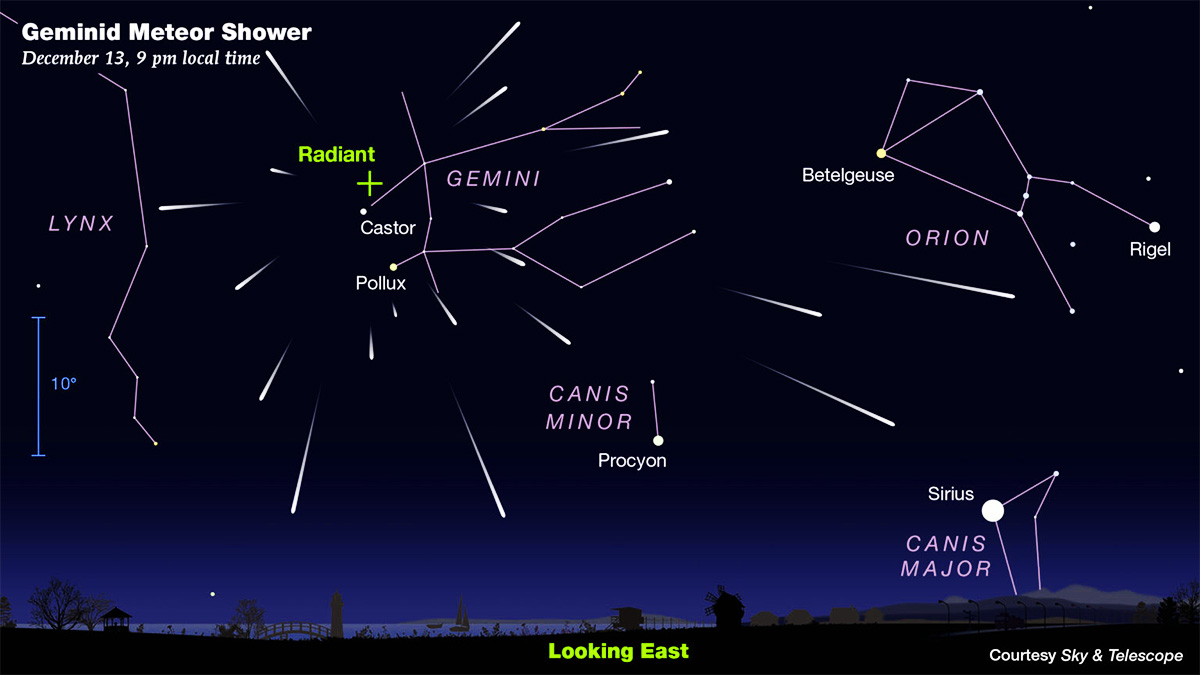
Here is what you need to know about this epic meteor shower and how we photograph meteors. We will also present where will be the best conditions.
Geminids 2023 is forecast to display one of the most spectacular events in years. No matter if you are in Europe, North America, Asia, or Australia, there are two greatest meteor showers every year. Those spectacular celestial events are August’s Perseid and December’s Geminid meteor shower.
When we are lucky enough, the moon is new and not shining in full, and the skies are crystal clear; these meteor showers’ peaks bring skywatchers hundreds of meteors worldwide through the peak nights. The Geminids and Perseids are the yearly most reliable and spectacular night sky events.
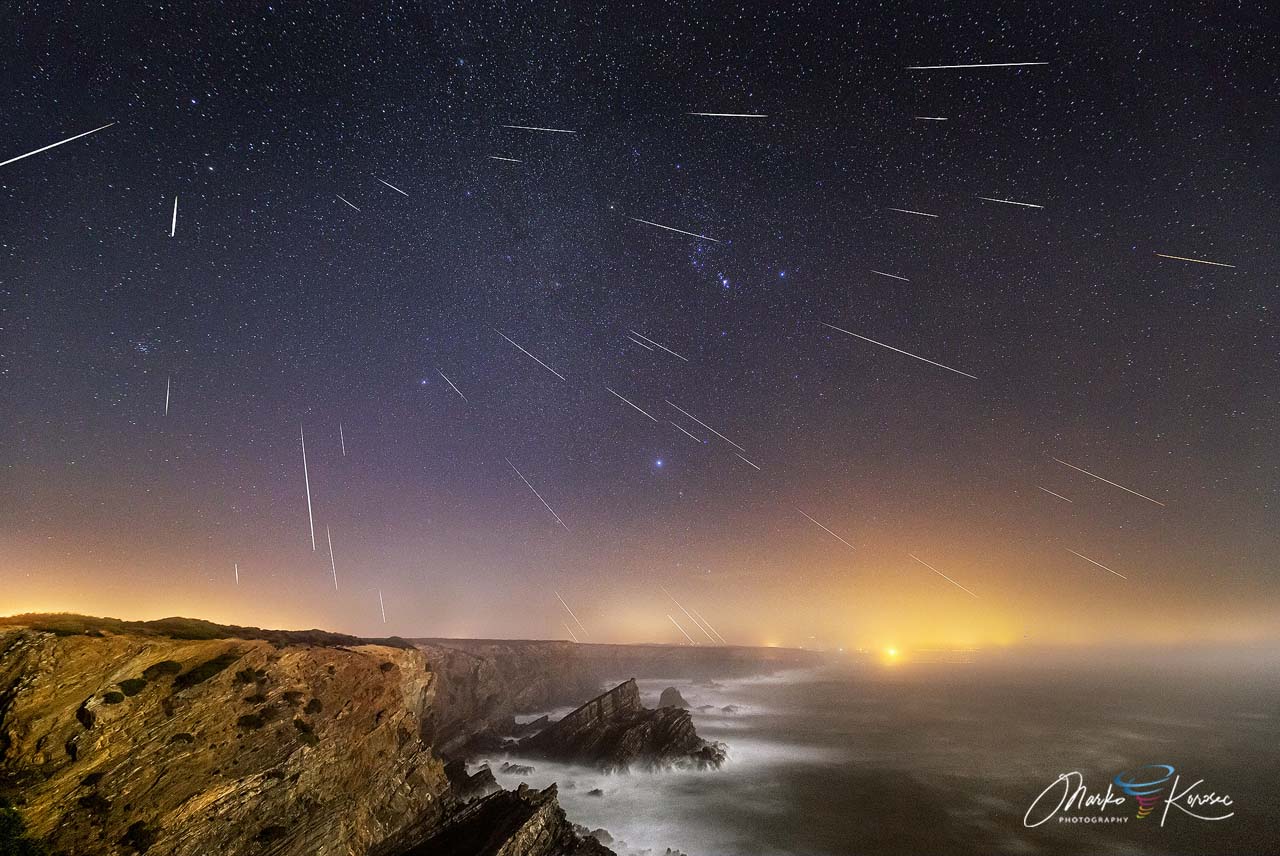
Above: Geminid meteor shower 2018 peak over Atlantic coast, Portugal. Photo by Marko Korošec
This week, on Dec 13th and 14th, 2023, the Geminid meteor shower is forecast to deliver one of the most spectacular displays in years! No Moon out all night will bring excellent observation conditions.
The Geminids are getting stronger yearly as the debris stream, their source, thickens over time. Their peak occurs very close to the Earth’s perihelion, when our orbital speed is greatest, typically leading to faster meteors.
Like the Geminid meteor shower 2020 and 2021, the peak coincides with no Moon, as the next new Moon is on December 12th, just two days before the highest activity. Thus creating perfect conditions worldwide, the rest will depend on the cloudiness.
The peak of the Geminid meteor shower this year occurs on Thursday, December 14th, at 19 UTC. That’s 8 pm in central Europe and 2 pm across the United States. In other words, this means the just *perfect* conditions for observers in Europe and the United States as night follows just a few hours after the forecasted peak.
Remember that although the peak typically happens on December 14th night (the second hard of the night when Geminids radiant is higher in the sky), the activity will remain relatively high also in the nights around, so from Dec 13/14th to Dec 15/16th.
WHAT IS THE FORECAST FOR GEMINIDS 2023 SHOWER?
The geminid meteor shower is the best-known and most reliable of the two major annual meteor showers; the other is Perseids. In the mid-latitudes across the Northern Hemisphere, the Geminids’ radiant rises just around local sunset, reaching the usable elevation for observations from the late evening hours until the dawn the following day.
The Geminid meteor shower 2023 is forecast to produce 80-120 meteors per hour under clear and dark skies each night from this Monday through Friday this week, with potentially even more than 150 meteors per hour during the peak hours on Thursday night, Dec 14th/15th. It is surely advised to observe all nights around the peak date.
In the Southern Hemisphere, the Geminids radiant appears usable only around local midnight hours, as it culminates near 2 am local time. So a short window this year with the Moon setting around 1 am. However, despite not having the ideal conditions, the Geminid shower produces a great show of often bright, medium-speed meteors.

While the Geminids are the best annual meteor shower, they also make observations difficult. The mid-December weather patterns across the Northern Hemisphere are often dynamic, and unsettled conditions are found in many locations under thick clouds or high moisture.
So observing conditions in winter is much more difficult than during the summer meteors, e.g., the Perseid meteor shower. Still, the skies are usually crispier due to colder temperatures and less haze.
Interestingly, observations of the peak rate of meteors (ZHR*) have slightly increased over a longer period and reached around 140–150 meteors per hour in recent years. And the near-peak Geminid meteor shower rates persist for several hours, so many parts of the world can enjoy at least part of the peak celestial show.
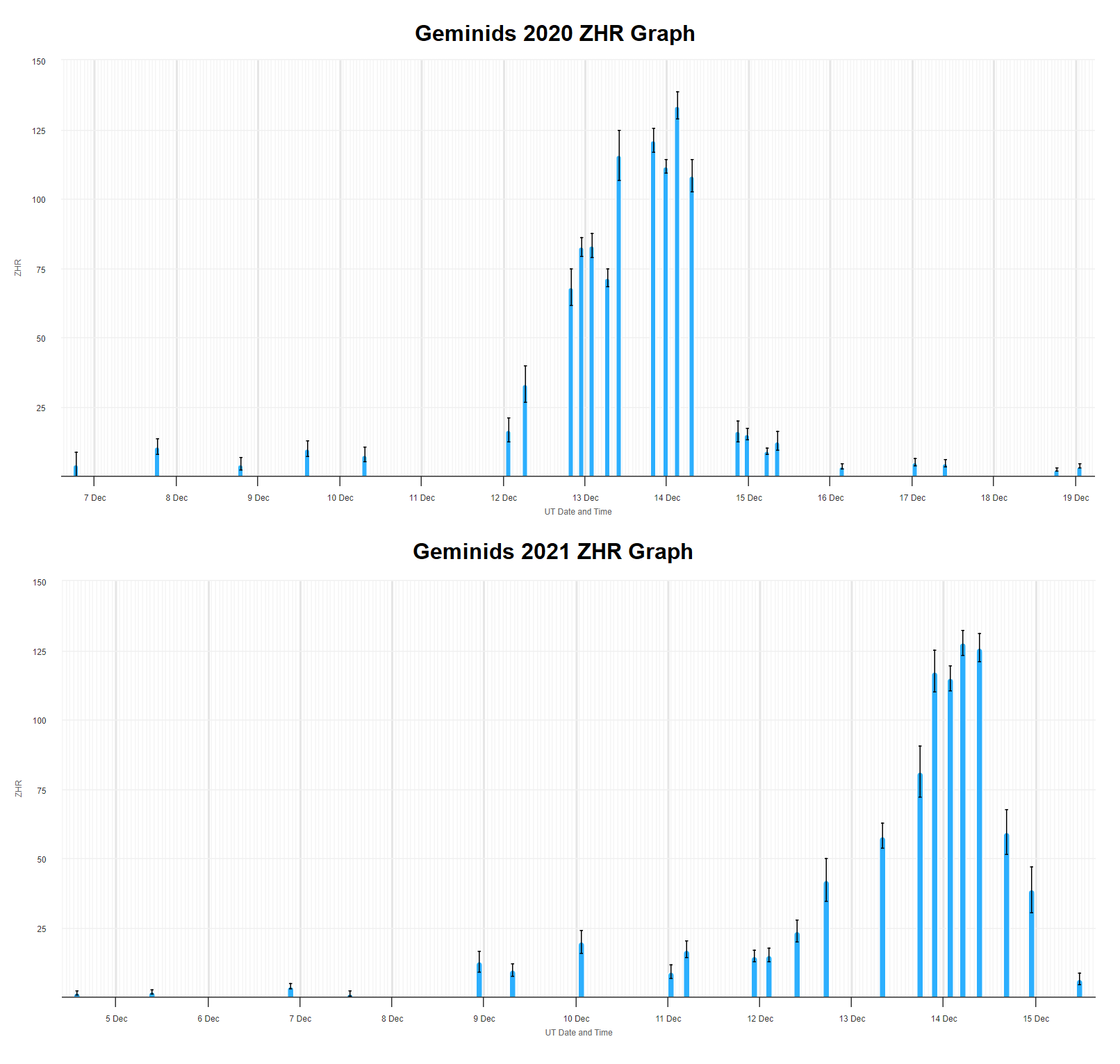
*ZHR – the Zenithal Hourly Rate of any meteor shower is the number of meteors a person would see in one observing hour during peak activity if it was at the zenith (directly above our heads). The conditions are excellent (dark skies are present, with stars visible up to magnitude 6.5). The hourly rate that can effectively be seen is almost always lower and decreases the closer the radiant is to the horizon.
And what is great about the Geminid meteor shower 2023 is that it will again return with a completely moonless night. Therefore the peak is optimally placed for a spectacular celestial show this year! Similar to those in 2020 and 2021.
WHAT ABOUT THE TEMPERATURE FORECAST?
As we are into the first month of the Winter Season 2023/24, we can expect colder weather. But will it be cold or decent warmth at your location during the long nights from Tuesday through Friday this week? Let’s see the high-resolution 2-meter temperature forecast for Europe and the United States below:
As we noted earlier, be sure not to wait until the peak night to watch and photograph the Geminids, as we expect all nights from Monday night through Friday night to produce a great meteor shower display for many locations.
Long story short: The new Moon and the Earth are in a great position for yet another spectacular celestial show this year. If the clouds will cooperate with us during the peak on Thursday night, Dec 14th, treat yourself to the greatest natural show of 2023 (or recent years)!
A HISTORY OF GEMINIDS – AN UNUSUAL METEOR SHOWER
The Geminids are, in addition, to be known as the strongest and the most reliable annual meteor showers. But also known as one of the weirdest meteor showers we know. While most meteor showers we observe originate from comets and icy dirtballs on elongated orbits around the Sun, the Geminid meteor shower originates from an asteroid. The parent body from which all the pieces that burn up in our atmosphere, such as the Geminids, is asteroid (3200) Phaethon.
Phaethon is a relatively small space rock, only about 5.8 km in diameter. The asteroid orbits the Sun in a very elongated elliptical orbit that takes it into the inner parts of the Asteroid belt as it is farthest from the Sun, to well within the orbit of Mercury as it is the closest to the Sun.

Above: An asteroid. Image: Universe Today
Phaethon is also designated as a potentially hazardous asteroid for us, as it can come as close as 2.9 million km to the Earth (7.6 Earth-Moon distances). However, it currently poses no impact threat to Earth. And the Geminid meteors are getting stronger every year and a half (approximately 18 months on average), as that is the time required for Phaethon to complete an orbit around the Sun.
Meteoroids are dust particles that produce meteors, and with most meteor showers, they come from comets. They are released from the comet’s nucleus by outgassing as the comet rounds the Sun and warms up. At the same time, an asteroid does not contain volatile ice that could produce outgassing as it rounds the Sun.

The core mechanism by which Geminid meteoroids are released from the Phaethon asteroid remains a mystery. However, the observations have shown it occasionally brightens and develops slight cometary features close to the Sun. That is why some researchers call it a ‘rock comet,’ proposing that bits and pieces break off the asteroid-like with the typical comet.
The asteroid’s surface can also heat up to 700 °C as it rounds the Sun with a distance more than twice as close as the scorching hot Mercury. It produces thermal stress on the rock on the asteroid’s surface and a breakdown of clay minerals being blown from the asteroid’s surface by the Sun’s radiation pressure.
Then, other researchers argue that the amount of Geminid meteoroids is so great that it could only have come from the breakup of a larger parent asteroid, with the largest remnant being the 5.6 km Phaethon asteroid.
Geminids – a young meteor shower
The first time Geminids were noticed in literature was in the 1830s, as there were no reports of sightings of this meteor shower before that. Therefore it is highly unlikely that the Geminid meteors would have been missed as other annual meteor showers. The Lyrids, the Perseids, and the Leonids had been observed for centuries.
Since the first reports less than two hundred years ago, the Geminid meteor shower has increased in strength. It is now the strongest annual meteor shower by quite a significant margin compared to other meteor showers. The summer Perseids are the second most active meteor shower after Geminids.
HOW CAN WE SPOT THE GEMINIDS IN THE SKY?
It is quite easy to find an area in which the Geminids excel. Unlike most other annual meteor showers, the Geminids can be seen well already in the evening hours. Geminids can be seen throughout the whole night! The visibility of the meteor shower and the number of meteors are closely tied to the position of the constellation of Gemini in the night sky.
All Geminid meteors will look like they come from a point in the sky in the constellation Gemini (The Twins): even on the other side of the sky if you trace a Geminid’s track backward, it will point to Gemini. This point in the sky is called the radiant. The higher the radiant is in the sky, the more meteors we can observe.
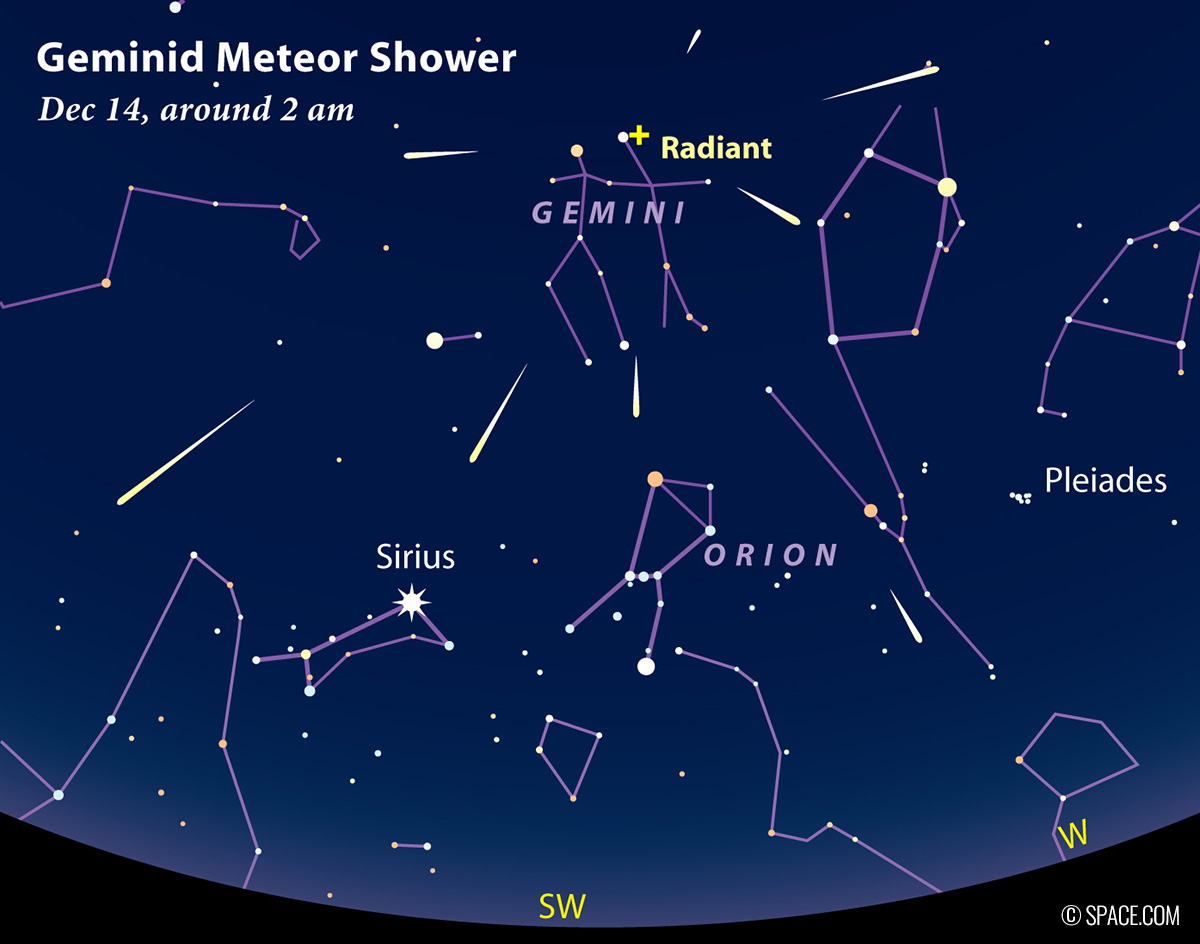
In the early evening, the Geminid’s radiant is low in the eastern sky, rising higher in the sky during the night hours. It is the highest around midnight and into early morning hours when the activity of the Geminid meteor shower will be highest. The activity diminishes towards the dawn as the radiant descends into the western sky, but there will also be plenty of Geminids in the sky just before dawn.
*******
As it happens with every meteor shower or night sky observation, one of the most important factors is the weather conditions. No matter how intense the meteor showers can be, how ideal conditions, altogether moonless nights, and crispy skies can bring, if there are clouds in the sky, you’re out of any chances to see meteors or the sky itself. Unfortunately.
So, let’s now see how the weather forecast will permit or limit the observations across Europe and the United States during the peak time on Wednesday and Thursday nights this week.
GEMINID METEOR SHOWER CLOUD FORECAST ACROSS EUROPE
The Geminid meteor shower 2023 over Europe will happen after quite a stable weather pattern. There will be a developing higher pressure and stable conditions over the western part of the continent, with a shallow upper wave disturbance situated over Eastern Europe towards the Balkan peninsula.
The upper-level ridging will build up from western Europe, expanding east and south towards central Europe. There will also be a blocking High over the Eastern Mediterranean and Turkey.

These patterns will allow relatively stable and good observing conditions in the broad zone extending from the Iberian peninsula across western Europe to Scandinavia, the Baltic region. As well as across central Europe and, indeed, Turkey. But stable weather is not all we want to know, as cloudiness depends on the inversion layers, which play an important role during winter.
Wednesday night, Dec 13/14th
If we look at the total cloud cover forecast across Europe during the pre-peak night (Wednesday night) below, we can see the cloudiness is likely to be spread across a large part of Europe. Very poor to non-existent chances are seen over western, northern, central, and eastern, thanks to the strong thermal inversions and cloud deck in the low to mid-levels.

Above: Cloud cover forecast over Europe for Wednesday night. Image by: Windy.com
However, some areas have pretty good conditions with almost no clouds. Many of the Iberian peninsula and the western Mediterranean, including parts of northern and southern Italy and southern France, can especially expect clear skies or good conditions for skywatchers.
Clear skies are also possible over the southern UK, Mediterranean, Greece, and Turkey. North Africa seems to receive excellent conditions as well for Geminids this year.
Thursday night, Dec 14/15th
As the peak for Europe occurs during the evening hours on Thursday, let’s see how the conditions will be for Thursday night. A developing large North Atlantic and West European ridge will help to bring fewer clouds into western and central Europe. It will remain cloudy over most central and eastern Europe and the Baltics, including Scandinavia. As well as most of the Balkan peninsula.
Observing conditions will remain good over the Mediterranean and south of the Alps. Also, northern Africa. Thursday night will favor good chances over southern France, Spain, Portugal, and northern Italy. And again, most of Turkey.
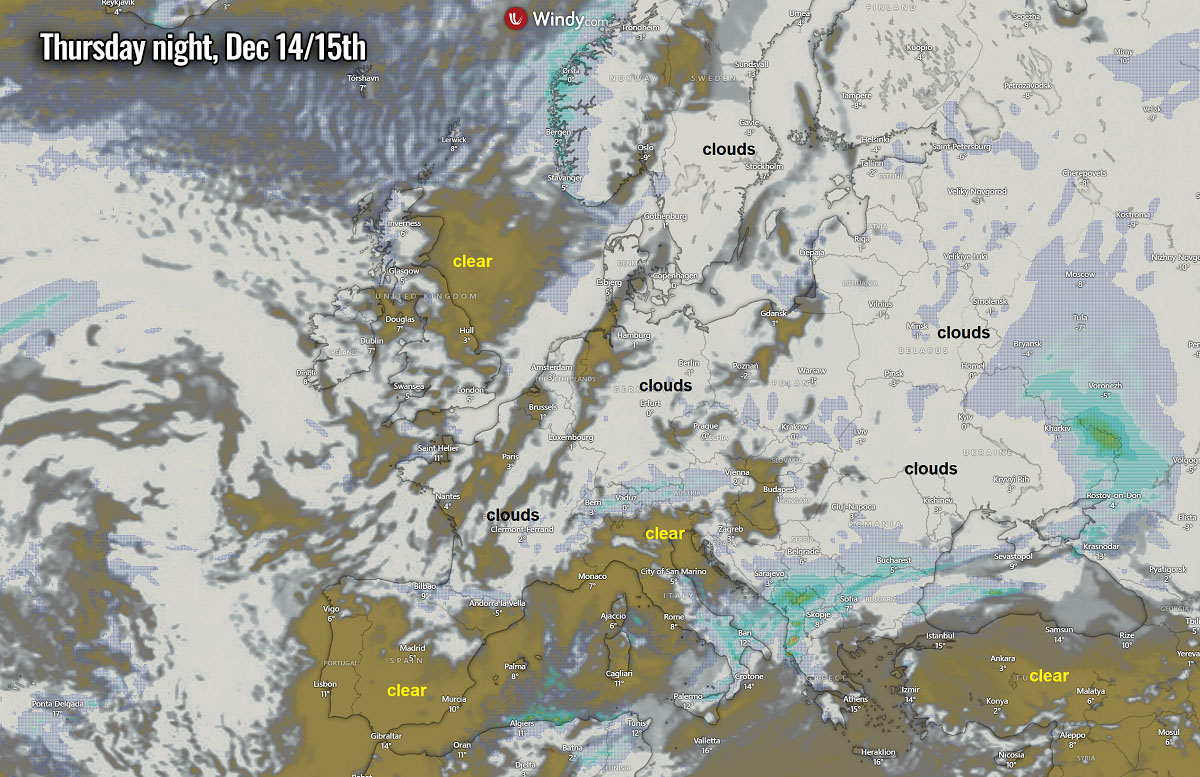
Above: Cloud cover forecast over Europe for Thursday night. Image by: Windy.com
As we can see, both nights will bring southern Europe into some good conditions. This should introduce great night conditions for skywatches and hopefully some fine Geminid meteors.
GEMINID METEOR SHOWER CLOUD FORECAST ACROSS THE UNITED STATES
Now let’s look at what is on the weather models for the United States skywatchers. A developing strong blocking pattern will take place this week across North America. An upper-level ridge strengthens across the northern and eastern parts of the country, including southern Canada. An upper low will be situated over Texas.
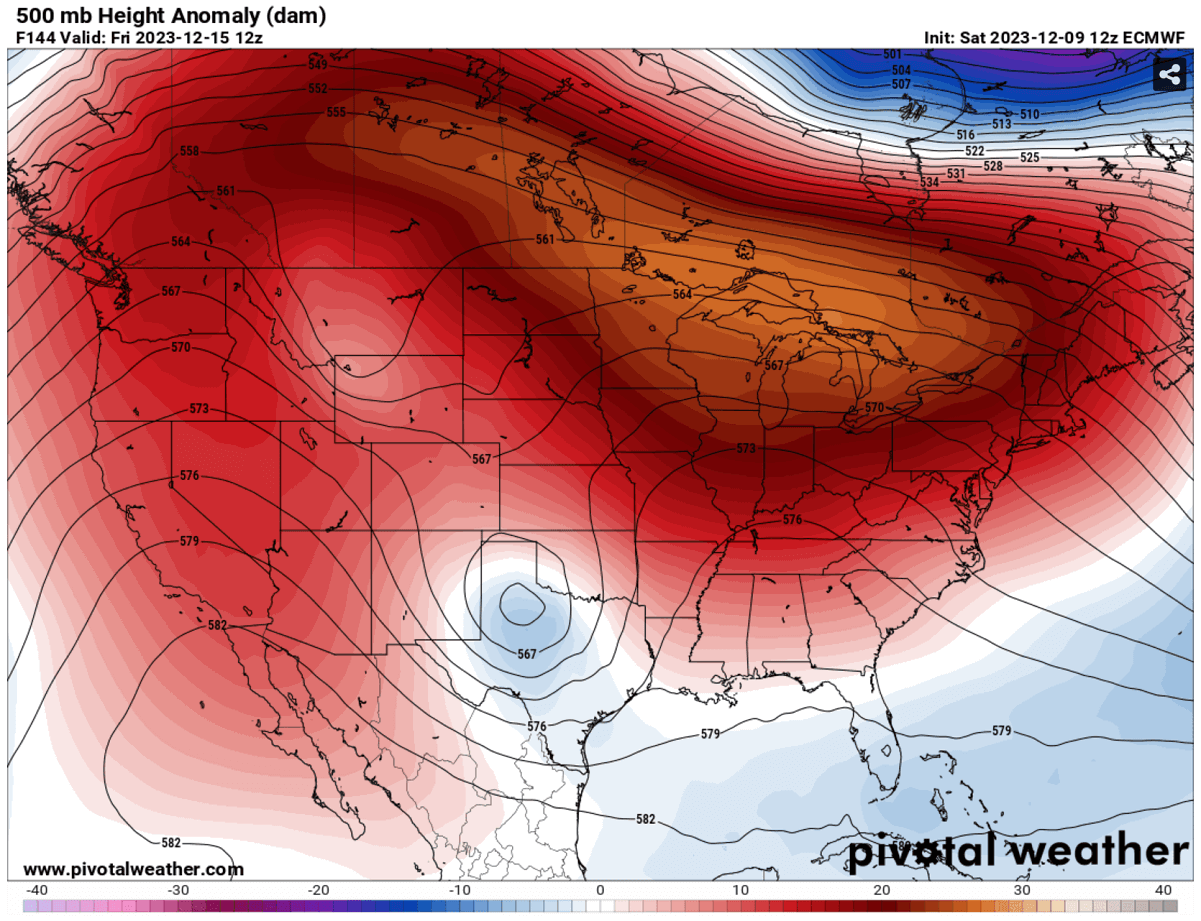
Under the blocking High, stable weather will spread east of the Rockies at least, so conditions will be favorable, and chances are pretty good for the Midwest, Northern Plains, Ohio Valley, and the Mid-Atlantic regions around the Geminid meteor shower peak this year.
Wednesday night, Dec 13/14th
Here is the cloud cover across the Contiguous United States on Wednesday’s pre-peak night. As mentioned earlier, the strong upper blocking will support less cloudiness. Therefore, chances are pretty good for many areas.
The conditions will be best across the northern Rockies to the east, the Midwest, the Great Lakes, the Ohio Valley, and the East Coast. Areas across the northern High Plains should have some lovely skies, especially as very dark skies are over there with very low light pollution.
Moisture will develop clouds over Texas and the Gulf Coast with a frontal system in place. Similar across eastern Canada and the Pacific Northwest.

Above: Cloud cover forecast over the United States on Wednesday night. Image by: Windy.com
Significant changes will also be made to spectacular shows across the Southwest United States and most of northern Mexico.
Thursday night, Dec 14/15th
The next night on Thursday will also give some good chances again. Clearing skies are likely across eastern Wyoming into Dakotas, parts of southern Canada, and across the Great Lakes into the East Coast, Southeast U.S., and the Mid-Atlantic states. Clear skies across most of Arizona, Utah, and northern Mexico.
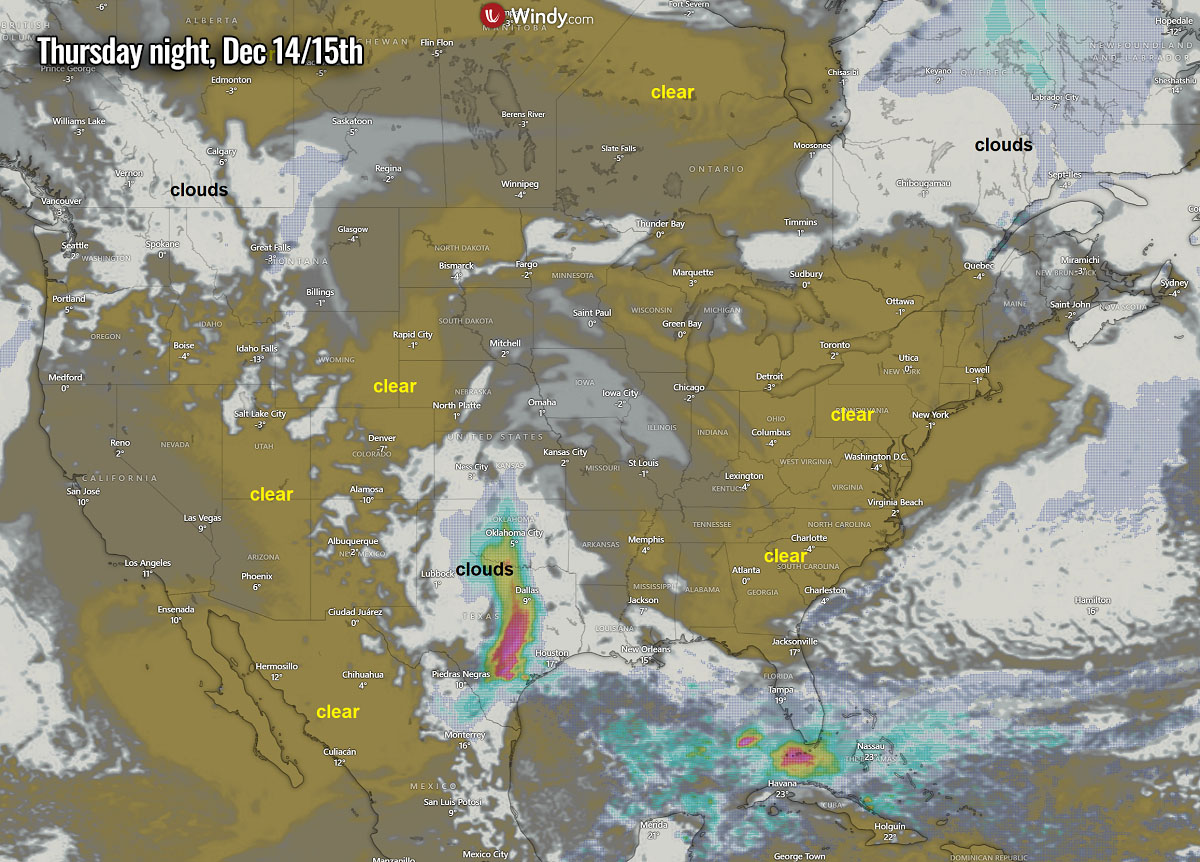
Above: Cloud cover forecast in the United States on Thursday night. Image by: Windy.com
Unfortunately, the frontal system emerging across the south-central Plains will bring clouds to Texas, Oklahoma, and Kansas and towards Iowa and Illinois on Thursday. As well as across the Mississippi Valley and the Gulf Coast. This will strongly limit the good chances for Geminids after the peak night.
So, as we can see, at least the western and eastern parts of the United States and the High Plains, including the Southeast and Northeast US, will enjoy good conditions this year. With no Moon in the sky all night and a high hourly rate of Geminids forecasted, skywatches can expect a spectacular celestial show!
METEOR PHOTOGRAPHY – HOW TO PHOTOGRAPH A METEOR SHOWER
It is always great to see some spectacular meteors that photographers catch with their cameras. It must be tempting to try it yourself, right? If you want to photograph the meteors, let us give you some tips.
No matter which meteor shower you observe, it is always fun. And with some luck, you can catch a big, bright meteor known as a fireball! Here is how you can get that shot too.
WHAT EQUIPMENT DO WE NEED
Similar to general photography, we need a camera, lens, tripod, and some luck. But when it comes to meteor photography, more specific equipment is necessary to get the best results out of your photography attempts.
- A digital camera with the option of making long exposure photographs. Any interchangeable lens camera (DSLR or mirrorless) will have this option, including compact cameras, and some phone cameras nowadays can also take long exposures.
- A sturdy tripod. The stronger, the better. Especially if you plan to photograph in higher elevations where winds could be more robust.
- A remote trigger for the camera (or timer, wired or wireless) helps you photograph continuously and without shaking the camera when pressing the shutter button.
- And indeed… a meteor shower. Preferably, it is the highest activity possible during peak events like Perseids and Geminids.

Perseids composite above Rijeka from mt. Ucka, Croatia. Photo: Marko Korošec
HOW TO PHOTOGRAPH – CAMERA SETTINGS
The best time to photograph meteors is during a maximum (known as the shower’s peak) of significant events, such as the Geminid meteor shower, Perseids, or Quadrantids. Moderately strong meteor showers, such as the Lyrids, Southern Delta Aquarids, Orionids, Taurids, Leonids, and Ursids, could be quite a show too.
Avoid using Auto and preset scene modes on your camera when photographing meteors or a night sky. You need to be in full control of the camera.
We need to set the camera mode to a long exposure. Several ways about it vary depending on your camera brand, but these are usually simple. One of the modes is the M – Manual. Some cameras may have B–bulb mode as well. This mode allows you to use a remote trigger for any exposure length.

Shutter priority mode (TV or S) is another helpful camera mode. With this mode, you can select the exposure time for your photo. And the camera will do the rest.
All interchangeable lens cameras have these photography modes; you will be fine regardless of the brand – Canon, Nikon, Pentax, Sony, or others on the market nowadays.
HOW TO PHOTOGRAPH METEORS – CHOOSING THE RIGHT LENS
Virtually any wide-field or standard lens will do its job, and so will any mid-range zooms. Most entry and up-to-prosumer crop sensor (DX or APS-C) cameras have a mid-range kit zoom lens, usually between 16 and 18 mm at the wide end and f/2.8 to f/3.5. These are fine for meteor photography.
The standard 50 mm lens is good too, and many of them have the aperture pretty wide open, usually f/1.2 to f/1.8. This lens can gather more light to capture fainter meteors than mid-range zooms. Indeed, the downside of these lenses is the small field of view, particularly on crop sensor cameras.

50 mm will not be too bad but do not use longer focal lengths as the field of view becomes too small. In other words, you are photographing a very narrow sky and will miss many meteors.
The best lenses for meteors are the recently released wide-field lenses with a maximum aperture of f/1.4 to f/2.0, available from several brands (Canon, Nikon, Samyang, Rokinon, and, especially, the Sigma Art lens).
Use a high ISO setting to capture meteors; 1600 or higher will be good enough. How far up the ISO scale you want to go depends mostly on your tolerance for noise and, indeed, the camera model. The recent cameras from various brands perform well, as sensors have improved significantly over the years. We can easily have low noise with even 3200 ISO or higher nowadays.

So now you can set up the camera with all the optimal settings. Prepare the camera, mount it on the tripod, and ensure it is leveled. Look through the viewfinder and make sure the horizon is perfectly on level.
The next is to focus on the lens. The easiest way to do it is to set it to manual focus and focus it on a distant light source or a bright star. Using the live view (with maximum magnification) makes the focusing job much easier.

Once you have the lens focus set, please keep them in manual focus mode to avoid the camera refocusing. Always switch the Image stabilization (IS) as well. Set the aperture to the lowest possible (fully open) and set the ISO.
You are ready to go. Be aware that you will take hundreds of photos before catching the first good meteor. Patience is the key to meteor photography. The more persistent you are, the more likely you will be able to catch a bright meteor!
Check the photograph above. It shows what a typical meteor will look like—a streak of light, likely greenish tint. Unlike the weather or communication satellites, a meteor will have a relatively smooth light curve – brightening steadily, brightest in the second half of its trail, with a more steep brightness drop-off at the end.
Irregular brightness flares can punctuate brighter meteors.
SOME ADDITIONAL PHOTOGRAPHY TIPS
These settings above were more or less the basic ones that we can get you into this interesting field of photography. Let’s see more tips on being even more successful and getting the best results.
Don’t get the background (sky) too bright; you want a good contrast between the sky and the meteors. Typically keep an eye on a histogram that has a peak around 1/8 to 1/6 full (left to right), which is considered optimal. This will depend on your lens, the ISO setting, and how dark your sky is. Fast lenses and high ISO settings will make your background brighter faster. A bright, light-polluted sky will also make the background brighter faster. An f/2.8 lens at ISO3200 under a good rural sky will take about 20-30 seconds.
Very fast and fully open lenses, e.g., the f/1.2 to f/1.8 lens, will produce the best results under dark skies. Brighter, light-polluted skies will saturate the background quickly, and meteors will have less contrast.

Do not use too short exposures. The shorter you go, the more likely you will get a ruined photo by ending the exposure in the middle of a bright meteor. This could be extremely frustrating. With a 10-second exposure, you will probably ruin 5-10% of meteors. So keep it at 15s or more.
Keep your horizon in the photo as many bright meteors appear close to the horizon. This is because you are looking through a larger volume of the atmosphere close to the horizon than overhead. If you use a 50 mm or another longer focal length, fast prime lens, keep your field close to the radiant. Otherwise, meteors will be too long to fit into your field of view.
Turn off your High ISO noise reduction as we can do noise reduction in post-processing easily, or even better.
Turn off your Long exposure noise reduction. In this setting, the camera makes a dark exposure for every photo you take – you will only photograph the sky 50% of the time, missing half the meteors. Few things are as frustrating as missing a superb meteor while your camera is making a dark exposure.

Numerous Perseids radiate from the constellation Perseus. Note the bright fireball on the left! Photo by Marko Korošec
Preferably, take photographs in RAW format or the RAW + JPEG combo. It pays off to have a RAW photo to edit later. It’s much easier than the JPEG format, no doubt about it.
Keep your white balance on AUTO, as it typically works best. You may want to change to a warmer setting (some photographers prefer 3700 K) under highly light-polluted skies. Or if there is variable cloud cover and the clouds are illuminated by light pollution or your camera has trouble keeping the white balance constant. As you take photographs in RAW format, you can correct the white balance in post-processing later.
Use Live View to point the camera to a bright star or distant lights to focus your lens. Make sure your focus is dead on. Keep your camera and lens in manual focus mode. Otherwise, it will try to refocus once you start your exposures, and your photos will be out of focus.
Avoid areas with moist air and better find a hilltop or a ridge; avoid depressions and valleys where colder and more moist air is trapped. Once your lens dews up, it is impossible to keep photographing. You can leave a spare lens in your car and use it as a replacement once your first lens dews up. Get the other lens into the car to warm it up. Alternatively, lens warmer bands are available from several suppliers: they run on batteries and keep the lens warm enough not to dew up.
Bring backup batteries. And spare memory cards. All of them. You don’t want to run out of batteries or space for peak activity.
Cameras do not see meteors as well as your eyes. A fairly bright meteor, as bright as the brightest stars, will register on your photo as a faint streak of light. You will need a bright one to produce a beautiful photo. Only if you use fast lenses and high ISO settings will even moderately bright meteors look significant. But do not be discouraged; you will get a great photo with a little luck and perseverance!
HOW TO PHOTOGRAPH PERSEID METEOR SHOWER WITH YOUR PHONE
Although smartphone cameras are far from as strong as traditional ones, they have improved significantly in recent years. The newer smartphone camera models are getting better every year, and with just a few photography tricks and some software add-ons, our smartphone can also bring high-quality images.
Here are a couple of tips on how to photograph meteors or a night sky in general, including the Milky Way, with your smartphone:
-
-
- Use a tripod – Using a tripod will ensure that your phone is steady and that there is no movement or shaking. Keep in mind that even the slightest movement can mess with long-exposure images. This means you wouldn’t get clear pictures even if you captured a meteor in the frame.
- Use the fastest aperture lens possible – To get the best night sky shots, a smartphone must gather as much light as possible. The latest smartphones have multiple camera lenses, so we have to choose the one with the broadest aperture, which should make stars and meteors brighter in the photos. If your smartphone offers a night mode, enable that as well.
- Download a long exposure app – Long exposure mode allows your smartphone camera to take multiple shots over some time. This is essential for capturing the fleeting nature of meteors since they are sporadic events. Some free mobile apps exist, for example, Easy Long Exposure Camera (iPhone) and Long Exposure Camera 2 (Android). Additionally, there are high-quality paid apps, e.g., Slow Shutter Cam (iPhone) or Night Camera (Android).
- Turn off HDR – The abbreviation HDR stands for High Dynamic Range. When you turn on this setting, the camera can combine multiple shots to include more light than is visible to the lens in one shot. This is normally good for shooting the sky but slows your camera’s capture speed. This increases the risk that you will miss meteors in the short time they are visible in the sky. So it is advised to turn this option off.
- Don’t use zoom – If you’re using digital zoom, zooming will lower the image quality, as even cameras with optical zoom lenses tend to have much less ability to gather light thanks to a more closed aperture. So, the standard focal length available with your smartphone’s fastest aperture lens is best.
-
WHAT TO EXPECT
As you are now really to get to the field, what can you expect? First, be ready to take many photos before a good catch of a meteor appears. Be prepared to spend at least an hour or two under the starry sky to catch a good one, even in the strongest of meteor showers, like the summer’s Perseid meteor shower or the Geminids in winter.
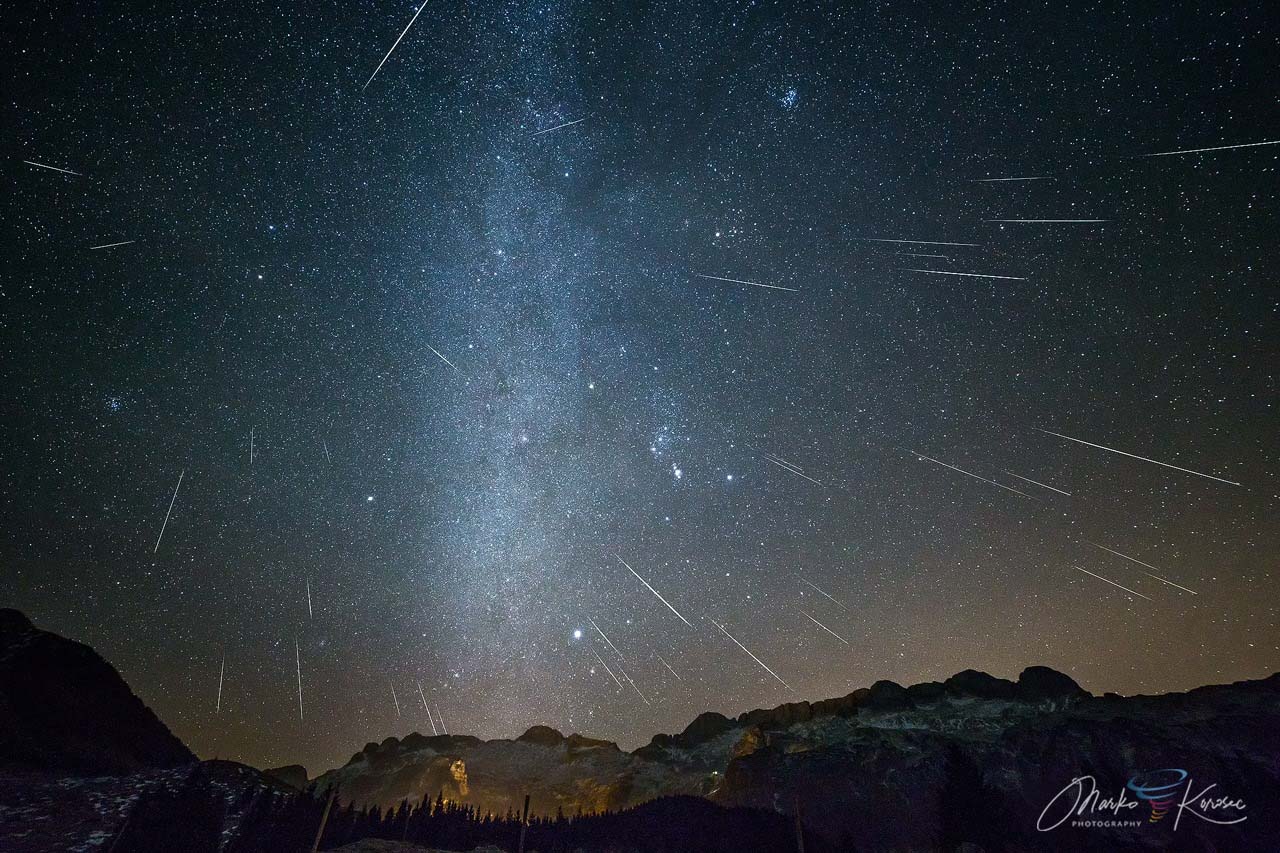
Above: A composite of the Geminid meteor shower over Mt. Kanin, Slovenia. Photo by Marko Korošec
Moderate meteor showers like the Lyrids or the Orionids take even more time as their hourly rate is lower than the most famous meteor showers. But patience does pay off. The more time you spend photographing meteors, the better the chances you will finally catch a good one, even a fireball.
Photographing a Perseid meteor shower can often bring hours and hours of taking hundreds or even thousands of photos. But, when things go right… whoa! Imagine you catch an exploding fireball. You will forget all the waiting until then!
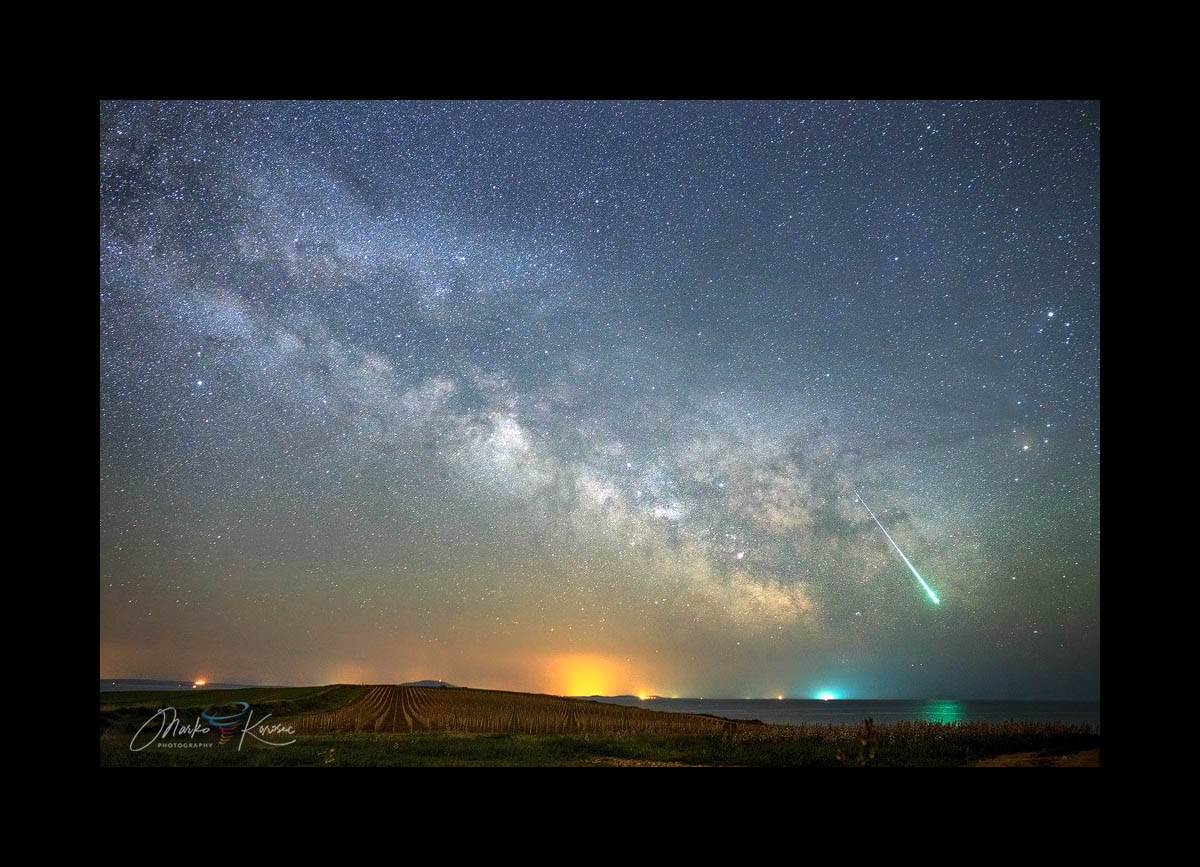
A Lyrid fireball flies down the Milky Way. Note the reflection in the sea. Photo by Marko Korošec
Wxcharts, Pivotalweather, and Windy, provided images used in this article.
See also: